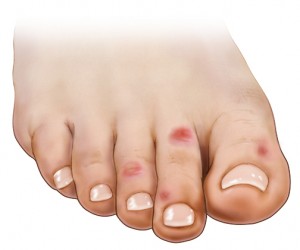Chilblains, also known as pernio, are small, itchy, red-purple patches on the skin that develop when the body begins to warm after prolonged exposure to cold temperatures.
This abnormal reaction to cold can occur in temperatures of 32–60° Fahrenheit (0–16° Celsius) after about one to five hours’ exposure.
Chilblains most commonly occur on the toes and the fingers but can also appear on the ears, nose, and other areas that are not protected from the cold.
These skin patches, which are often painful, are the result of the inflammation of small blood vessels and can also appear as swellings, blisters, or ulcerations.
Chilblains can occur at any age, although children and elderly persons are the most vulnerable to cold-induced skin disorders. The condition is reported to occur frequently in athletes, particularly ice skaters, hockey players, and speed skaters, and in persons with circulation problems.
Although usually a temporary condition that resolves on its own, chilblains can become chronic and recur for years during cold months. The condition may also occur as part of cutaneous lupus erythematosus.
Chilblains may or may not require treatment, depending on the severity of symptoms. The best approach is to prevent chilblains from developing by limiting your exposure to cold and dressing warmly.
Because chilblains can lead to infection, it is important to monitor your skin carefully during the healing process.

Chilblains Symptoms To Watch For
Skin changes caused by chilblains may include one or more of the following:
- Small, itchy patches with reddish purple discoloration
- Swelling
- Pain
- Burning sensation
- Blistering
- Ulceration
Why Do I Have Chilblains?
Why chilblains develop in some people and not others is unknown. The abnormal reaction of the body to rewarming after cold exposure may be caused by a defect in the small blood vessels near the skin’s surface.
As a result, these blood vessels expand more quickly than the adjacent larger blood vessels can handle, and the small vessels respond by leaking blood into nearby tissues. This inflammation manifests as the characteristic skin changes.
Chilblains more commonly occur during the winter months. Certain factors may increase your risk of developing chilblains:
- Occupation that requires work in cold or damp conditions
- Female sex
- Weight is 20 percent below average for height and age
- Poor circulation
- Previous diagnosis of Raynaud’s phenomenon (skin turns white after temperature changes or emotional events)
- Geographic location can be factor if the area has below-normal temperatures
When Should I See a Doctor?
You may not need to see a doctor if you can manage chilblains on your own with an over-the-counter cream or lotion. If the pain, itching, and skin changes persist after a week or two, contact your healthcare provider.
Most people can still function despite the symptoms. Chilblains on the foot should not cause problems with walking. Severe pain, painful swelling, blistering, and ulceration can be signs of a more serious condition or infection.
If you have any of these symptoms, you should seek immediate medical attention. For those with poor circulation or diabetes who discover chilblains, it is important to see a doctor immediately to prevent possible complications.
How Are Chilblains Diagnosed?
Your primary doctor may be able to diagnose your chilblains simply by looking at your skin, performing a physical examination, and asking you questions about your condition and medical history.
In some instances, your doctor may refer you to a dermatologist if the diagnosis is unclear, or to a cardiologist if a circulatory disorder is suspected.
Chilblains may be harder to diagnose when the condition occurs at an unlikely time of year, or if the skin changes are atypical. Chilblains can also occur in other areas on the body, so be sure to point out any skin changes to your doctor.
Chilblains can be confused with other conditions, such as Kaposi sarcoma (a low-grade vascular tumor associated with human herpes virus-8 infection). It can occur in association with lupus erythematosus and circulation disorders.
If your doctor cannot rule out these conditions on the basis of your symptoms and medical history, you will be referred to a specialist.
A diagnosis is usually made after an examination of the skin of the feet and hands and other areas of the body that present the characteristic purple-red patches of chilblains. You may not need any further evaluation unless another underlying condition is suspected.
What Are My Treatment Options For Chilblains?
Chilblains usually resolve within one to three weeks. During this time, you can manage the condition yourself by keeping the affected skin warm and by using an over-the-counter cream or lotion that is designed to alleviate itching and swelling.
These over-the-counter products may help, but there is no evidence that they can reduce the symptoms of chilblains. The affected skin should be cleaned with an antiseptic and bandaged to prevent infection.
It is important to avoid scratching the area, as this can lead to breaks in the skin. Once the skin is broken, infection is more likely to occur.
People with poor circulation, who tend to be more sensitive to changes in temperature, may be given a prescription for a medication that lowers blood pressure or improves blood flow.
These drugs can be taken orally and are sometimes used to treat chilblains because they can open up blood vessels.
Can Chilblains Be Prevented?
If you have had chilblains, you may develop them again. It is important to protect your skin from cold temperatures, and when you are exposed to the cold, rewarm your skin gradually.
- Keep the affected areas warm by staying out of the cold, dressing warmly, and wearing gloves, socks, and hats when outdoors.
- If you use tobacco, consider quitting. Smoking can make chilblains worse.




